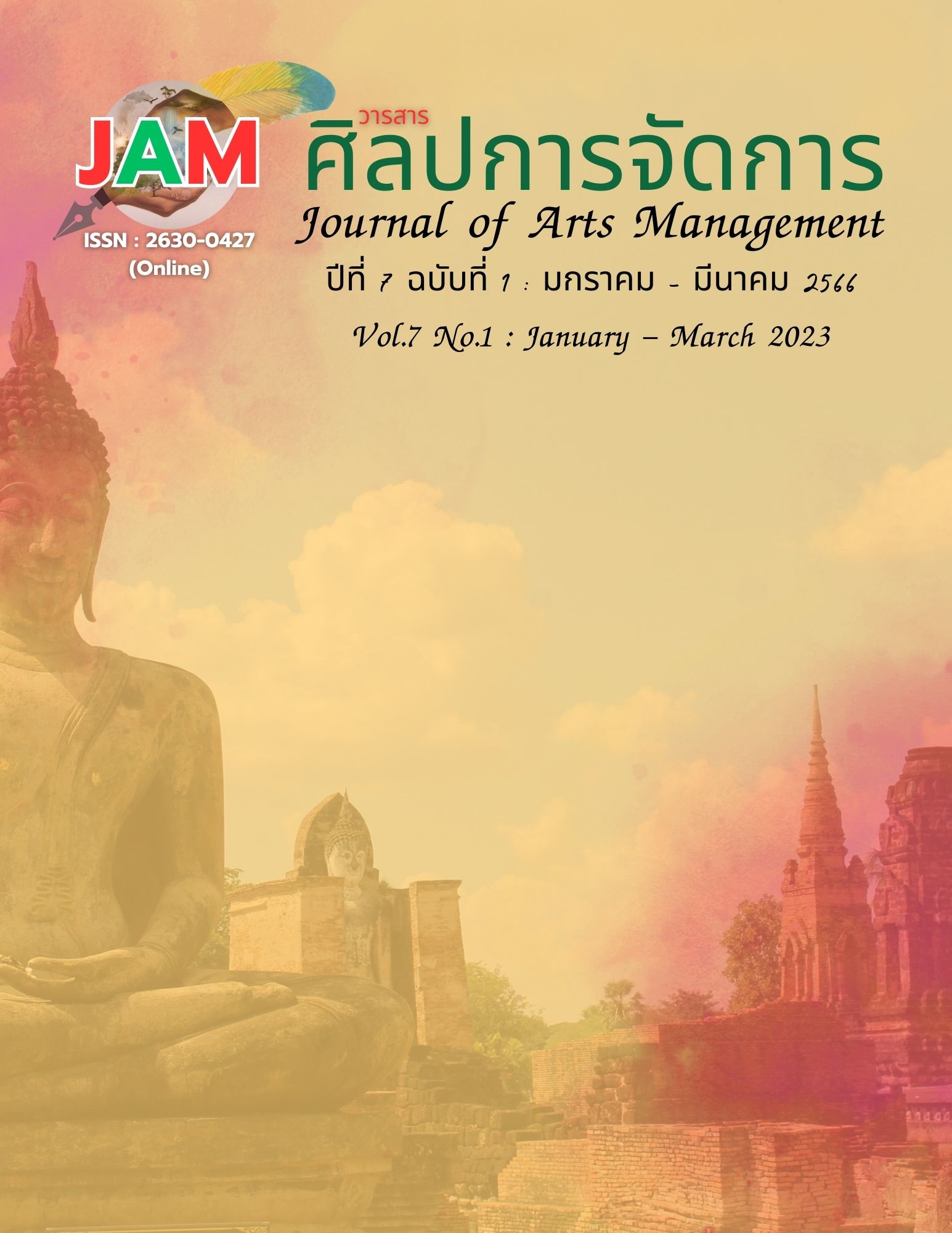Creation of Added Value of Traditional Weaving Products of the Thai Puan People in Pak Phli District, Nakhon Nayok Province to Commercialization
Main Article Content
Abstract
This study examines the creation of value-added products of traditional weaving fabrics of the Thai Puan people in Pak Phli District, Nakhon Nayok Province for commercial purposes specifically. The objectives were 1) to increase the value of the prototype product processing, 2) to transfer technology to the Thai Puan weaving group, 3) to disseminate the prototype product processing manual and 4) to create an economy for the community to move towards commercialization.
The results showed that most of the respondents were female (98 percent), aged between 41-50 years old (48 percent), and most of the sample's education level was higher than a master's degree (48 percent).) Most of them are self-employed/independent businesses (76 percent) and the monthly income of most of the samples earns more than 20,000 baht (50 percent) in the satisfaction assessment form of woven fabric products of the Thai Phuan people in the overall average all 4 aspects. The type with the highest satisfaction score was type 4 (4.44 - most) and the lowest type was type 3 (4.02 - more).
The suggestion for further research is to study the development of products that have multiple uses in one piece, such as a bag and it can also be a doll or display item in the same piece by folding or turning the fabric, etc., to create novelty for the community's products. The study also suggests increasing distribution channels to increase a variety of consumer groups at all levels of society and the study of the application of new fabric patterns from traditional patterns including giving the color according to the fashion of that era for a variety of raw materials that will be processed into new products.
Article Details

This work is licensed under a Creative Commons Attribution-NonCommercial-NoDerivatives 4.0 International License.
Views and opinions appearing in articles in the Journal of Arts of Management It is the responsibility of the author of the article. and does not constitute the view and responsibility of the editorial team I agree that the article is copyright of the Arts and Management Journal.
References
Angkhapakornkul, A. et al. (n.d.). Unique fabric pattern of Nakhon Nayok Province. (n.p.).
Boonsom, W. (2017). A Comparison of Symbolic Textile Patterns among the Lao Phuan in Chieng Kwang, Lao People’s Democratic Republic; the Thai Phuan in Ban Mi, Lopburi Province; and the Thai Phuan in Hat Siao, Sukhothai Province, Thailand. Journal of Mekong Societies, 13(1), 171–187. https://so03.tci-thaijo.org/index.php/mekongjournal/article/view/84931
Nakhonnayok Province. (2008, Oct). General information: Pak Phli. https://ww2.nakhonnayok.go.th/amphur_content/cate/3
Panthong, P., & Prasitphol, W. (2021). Communication model for cultural inheritance of Bann Mai Thai Phuan hand woven fabric in Nakhon Nayok province. SAU Journal of Social Sciences & Humanities, 5(1), 146–160. https://so05.tci-thaijo.org/index.php/saujournalssh/article/view/252687
Piroj, K. (2018, August 11). What is the Likert Scale? (Likert's Scale). Greedisgoods. https://greedisgoods.com/likert-scale-%E0%B8%84%E0%B8%B7%E0%B8%AD/
Poonyaprapha, P., Supasetsiri, P., Inchan, N., & Nopudompan, K. (2018). The Factors Effect to Wisdom and Inheritance of Thai Phuan Hand Woven Fabric at Ban Mai, Nakhon Nayok. Academic Journal of Social Communication Innovation, SWU, 6(1), 158–168.
Princess Maha Chakri Sirindhorn Anthropology Centre. (2022). Ethnic Group in Thailand: Tai Puan. https://www.sac.or.th/databases/ethnic-groups/ethnicGroups/83
Roonreangjai, R. (2017). A Study for Developing Modern Patterns of Tin Chok Thai - Phuan Fabric with Dobby Weave at Hat Siao Sub-District, Si Satchanalai District, Sukhothai Province. Journal of Industrial Technology: Thepsatree I-TECH, 12(1), 63-71.
Thai Phuan weaving fabric, Ban Mai, Nakhon Nayok Province. (2019). Suphannika Flower Pattern Fabric. https://www.facebook.com/thaiphuonbanmai/
The Institute for the Promotion of Teaching Science and Technology (IPST). (2020). Value creation. IPST. http://designtechnology.ipst.ac.th/wp-content/uploads/sites/83/2020/01/4_02%E0%B8%81%E0%B8%B2%E0%B8%A3%E0%B8%AA%E0%B8%A3%E0%B9%89%E0%B8%B2%E0%B8%87%E0%B8%A1%E0%B8%B9%E0%B8%A5%E0%B8%84%E0%B9%88%E0%B8%B2-1.pdf
Wikipedia, The Free Encyclopedia. (2022, April 17). Thai Phuan People. https://th.wikipedia.org/wiki/%E0%B8%8A%E0%B8%B2%E0%B8%A7%E0%B9%84%E0%B8%97%E0%B8%9E%E0%B8%A7%E0%B8%99
Wong-Aree, T., Duongjun, W., Chompuwise, P., & Putgeaw, P. (2015). Native Fabrics of Tai Phuan’s Wisdom: Pattern and Textile Design Banchaing’s Culture from the Past to Present. Journal of Community Development and Life Quality, 3(2), 195–202. https://so02.tci-thaijo.org/index.php/JCDLQ/article/view/132489/99520
